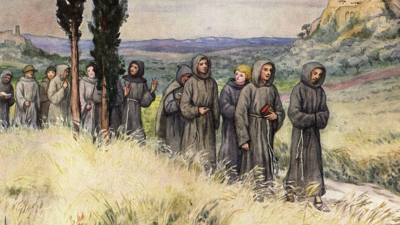The Itinerant Life of the Brothers
St. Francis of Assisi
The fraternal life with Francis was not centered in a monastery but harkened to the tradition of wandering for the sake of Christ, an ascetic homelessness.

As we noted in the previous article, Francis expected his brothers to learn by imitation – and to understand that as Francis sought to imitate Christ, so too should the brothers. But in reality, the first generation of Assisi-area brothers simply did what Francis did: daily prayer, work at a local leprosarium, go to local churches to participate in Eucharist, eat, pray again, witness to the local Umbrian people near Assisi, and live a life in community. You have to remember this was all new. Prior to this “Franciscan moment” the spiritual journey of medieval people consisted of being a monk or cloistered nun behind the walls of the monastery, being a priest and living close to the sacraments and the Scriptures, or being a lay person and hoping the other groups were praying for you. And then along comes this different, new, intriguing way of being spiritual in the world. And it was not set down in writing; it did not come with instructions. But sometimes it is borrowed from the past.
From the fifth to the 12th centuries, the monasteries were centers of education, culture, and mission – a visible sign of the reign of God, which openly rejected the world that had slipped into the Dark Ages. The monks came to be regarded as the expression of uncompromising Christianity and were seen to hold the position once occupied by the early Church martyrs. An unusual monastic spirituality emerged in the West that was suited for being in the world: pilgrimage. What began among the Irish monks as a penitential practice, i.e., ascetic homelessness, became a form of pilgrimage signifying renunciation. The monks were peregrination pro Christo (“wandering for the sake of Christ”).
But the monks and religious were not the only ones wandering on the road. The thing to remember is that during this time western Europe was beginning to emerge from the darkest period of the medieval era. There were many peoples on the move, homeless, without land or means. Among the poor and needy were thieves and brigands and so people in residential or stable situations were cautious about dealing with the vagabonds. The early friars intentionally dressed as the poorest people and as such were not noticeably religious.
From the beginning, Francis and the small band of friars practiced a type of ascetic homelessness. Francis himself spent a good portion of the early years (1209-1215) wandering, especially in the east of Italy in the Marches of Ancona. There he established several hermitages, remote places of prayer and contemplation, as well as encountered people of that place. The earliest accounts do not record these trips, but later accounts, written by his earliest companions, record the wanderings, the prayers, and the daily life of work or begging.
The other friars took up this same practice. It is seen in their practice of prayer and hermitage and in their peregrination pro Christo. When Bernard and Peter joined Francis they sold their goods, distributed monies to the poor, worked at the leper hospitals, took menial jobs in return for food, supplies, and sometimes alms. They took up residence at the Porziuncola but early on seemed to leave for spiritual reasons. Peter and Bernard soon took up a pilgrimage to Spain.
Along the way Peter and Bernard reached Florence, a four to five day walk. When they arrived, they went door-to-door asking for shelter. One woman, although she refused them shelter in the house, pointed them to the bakehouse under her portico. Her husband objected thinking they were a security risk – but the only thing to steal was firewood. The two friars arose early as was their custom and went to the local chapel at three or four in the morning to pray Matins. Later when the women went to morning Mass she found the brothers there already in church, reciting prayers before the crucifix.
After Mass a local merchant, Guido, who was known to give alms to the paupers present at Mass, approached the friars and offered them alms. The brothers thanked him but refused his offer saying that they had become poor for Christ. They did offer to work for food or shelter. Guido was taken aback since even the poor of the Church (monks) accepted alms. When he asked who they were, they replied that they were penitents from Assisi.
Often the brothers were seen as pious tramps –tramps because of their homelessness and pious because of their habitus of prayer. Occasionally the brothers spoke about their love of God and their decision to live a life of penance – and they continued to work out what it meant to follow Christ in fraternity with Francis of Assisi.
In time this peregrination pro Christo became part of the impulse to move beyond the borders of Umbria and Assisi. And as the brothers traveled, they became increasingly known as men of God because of the example of their lives.